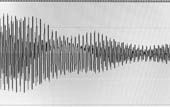
Purpose
To demonstrate how sound waves can penetrate various types of materials.
Additional information
Sound is transmitted through gases, liquids, solids, and plasma as longitudinal waves. The energy carried by longitudinal waves, also known as compression waves, converts back and forth between potential energy of the compression and the kinetic energy of the oscillations within the medium. This displacement of the sound wave results in oscillation.
There are many modern and classic technological achievements that take advantage of sound waves. Doctors and scientists use sound waves to see into our bodies. Stethoscopes are used to amplify sound waves so doctors can listen to our heartbeats while ultrasounds are used to create images of our hearts and stomachs. Other equipment that is used for generating, manipulating, or amplifying sound waves include hearing aids, musical instruments, and sonar systems.
Sponsored Links
Required materials
- Three drinking glasses of the same size
- Water
- Ice Cubes
- Slinky
- Pen or pencil
- Journal (to record results)
Estimated Experiment Time
About 15 minutes.
Step-By-Step Procedure
- 1. Place the three glasses in a row on a table or other solid surface.
- 2. Fill the first glass about two-thirds full with water.
- 3. Fill the second glass about two-thirds full with the ice cubes.
- 4. Leave the third glass empty.
- 5. Tap the glass by giving it a flick with your finger. What sound does it make? If you shake your hand while tapping the glass can you see the vibration?
- 6. Tap the glass that has the water in it. Note the sound that it makes.
- 7. Tap the glass with the ice cubes in it. What sound does it make? Note the difference between the other glasses.
- 8. To demonstrate how the sound is traveling when you tap your glasses, you'll use your slinky. Stretch the slinky out and give one end a push or shake. The wave that travels the slinky from one end to the other demonstrates a "longitudinal wave", which demonstrates how sound travels.
- 9. Higher pitched sounds travel at a faster rate while the lower pitched ones travel at a lower rate. Now tap your glasses again, each time giving your slinky a shake to demonstrate faster and slower sound wave travel. Note in your journal the sound waves for each glass.
- 10. You can explore other sound waves around your house by finding various objects and tapping them. Each time give your slinky a shake to visually see how the sound is traveling. Notate your results in your journal so you can compare and contrast the results.
Note
If you don't have a slinky, you can try using any large spring to demonstrate the longitudinal waves that occur when you tap the glasses.
Observation
Can you give some examples of advanced technology that primarily uses sound waves?
Result
Sound is vibration that travels in longitudinal waves and travels through matter - liquid, air, gas, and solids. When you make a sound, the vibration moves the matter particles around it, which in turn move the next set of particles, carrying the pulse of the vibration in a wave. When you tap the glass and shake the slinky, it demonstrates how the sound waves travel through the different materials.
Sponsored Links
Take a moment to visit our table of Periodic Elements page where you can get an in-depth view of all the elements,
complete with the industry first side-by-side element comparisons!